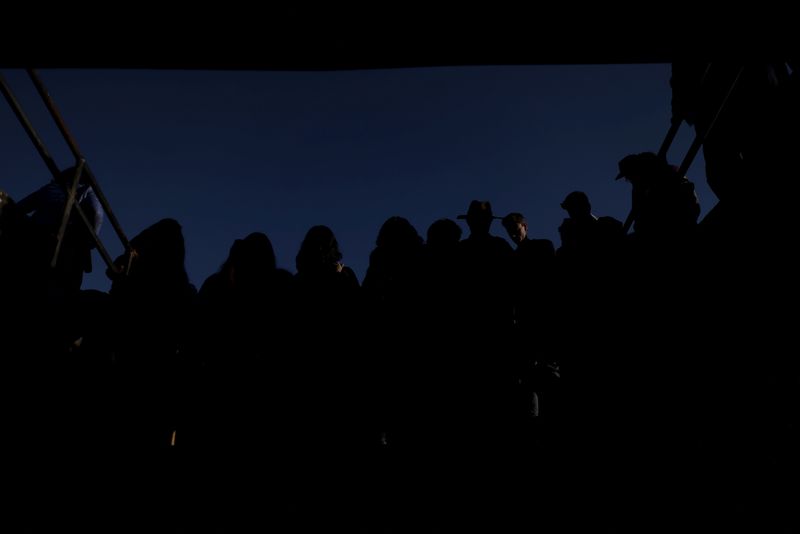Chile political prisoners reclaim torture sites to preserve coup memory
2023.09.09 05:38
3/3

© Reuters. People visit Estadio Nacional memorial, a former detention and torture center of the Augusto Pinochet dictatorship, in Santiago, Chile, August 26, 2023. REUTERS/Ivan Alvarado/file photo
2/3
By Ivan Alvarado and Natalia A. Ramos Miranda
SANTIAGO (Reuters) – Viola remembers the terror of being naked in front of her captors, the blows to her body and the pain. Carlos recounts being barely able to breathe amid beatings that left his ribs broken. For Alejandra, some horrors she would rather not put into words.
Fifty years after a 1973 coup in Chile that ushered in 17 years of brutal military rule and saw some 40,000 people imprisoned, disappeared, tortured or killed, Reuters went with five former political prisoners to the sites of their confinement. The testimonies of three are included here.
These places have become focal points of shared memory as victims and their families look to gain more control over the past, find out still hidden truths, and seek accountability for what took place during the dictatorship of General Augusto Pinochet.
Carlos Gonzalez was arrested and tortured by Pinochet’s secret police in 1976 at the age of 28. For months he was held in detention centers, including the Tres Alamos and Cuatro Alamos political prison camps in Santiago.
“They beat you constantly. They beat you before asking you anything, you couldn’t breathe,” he told Reuters at another former detention center, the Clinica Santa Lucia. “Doctors examined us with absolute contempt, they verified blows and injuries and you returned to the cell. Then you were beaten again.”
“Torture is never erased from your mind. And sometimes, not from your body either.”
Gonzalez said he had been a union activist and supporter of leftist former President Salvador Allende whom Pinochet had deposed in the coup, but worked in a bank and was no radical guerrilla. “I was not very important,” he said.
According to various official commissions, the total number of victims of the dictatorship is 40,175 people, with over 1,000 still missing. Chile returned to democracy in 1990, though Pinochet himself was never convicted of a crime and died in 2006.
The Valech Commission, which was set up in the 2000s to investigate dictatorship-era rights abuses, established that firing squads, systematic torture, deprivation of liberty in illegal precincts, and violations of human rights had been a “state policy”.
Incorporating testimonies from more than 30,000 people, the Valech Commission found that women were also often the target of sexual violence.
Alejandra Holzapfel was held at a clandestine center known by police as “Venda Sexy” (“sexy blindfold”), notorious as a place where sexual violence was used as a form of torture and where police agent Ingrid Olderock trained dogs to torture detainees.
Holzapfel was just 19 then and was a militant in the MIR, a far-left armed guerrilla revolutionary group that fought military rule.
“I don’t think I’ll be able to enter that house. I returned once in 1990 to remember it and it was terrible,” she told Reuters, who photographed the 70-year-old outside the estate that is now being converted into a site of remembrance.
“I don’t like to talk about it, I don’t like it because it re-victimizes me and hurts me,” said Holzapfel, who said she planned to escape after the emotional intensity of the anniversary by traveling to northern Chile to visit her grandchildren.
“We have spent our lives trying to make people understand that what happened to us is real… the only thing you want is for it not to happen again,” she said.
Viola Todorovic, 69, says the first time she was tortured she almost went into cardiac arrest. She was 19 and a MIR activist. She recalled being blindfolded and gagged at the Londres 38 former detention site.
“You had to undress, they touched you. It was a horrible situation, it was worse than even having electricity put on you, but you couldn’t say anything either because they could see that was your weak point,” she said, visiting the building in downtown Santiago that is now a memorial site.
She also spent almost a year in Tres Alamos, where she recounts that despite the torment, female prisoners created ways to support each other. They knitted, organized workshops, distributed food, and forged ties that remain.
“You had no choice but to survive. They sought to break you and destroy you as a person,” she said. “In many cases, they succeeded.”








